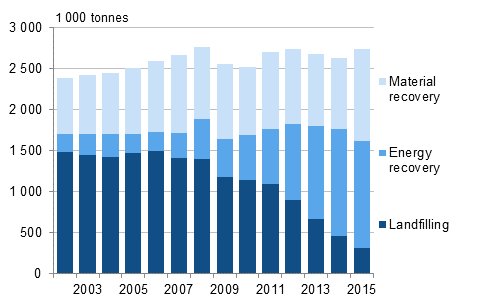Published: 20 December 2016
Incineration and recycling of waste have replaced landfills for municipal waste
The disposal of waste in the bank on landfill sites has become rarer. Last year, only good one tenth of municipal waste was disposed in this manner. It has been replaced by recovery of waste. Energy production and recycling have competed for the recovery of freed landfill waste. Energy use of waste is winning.
Municipal waste by treatment method in 2002 to 2015

Increasingly more municipal waste is burnt
Nearly one-half of all municipal waste is burnt in Finland's seven incineration and co-incineration plants. The growth has been strong in waste incineration. Over the past decade, the incineration capacity has grown six-fold and will grow this year by two new plants. Mixed waste is turning into mere energy waste and separately collected waste into recycled material.
Recycling strengthened
Recycling refers to restoration of waste material to use. Recycling is the most pursued method for a waste management alternative in the whole of Europe. Last year, Finland took a substantial stride towards top countries in recycling of separately collected municipal waste. The recycling quantities of electrical and electronic waste and glass and metal waste increased. The most influencing factor was, however, the specification of the quantity and recycling of fibre packaging waste generated in the field of trade. The recycling rate of fibre packaging waste is very high.
Total quantity of municipal waste has been standardised
The quantity of municipal waste has been 2.4 to 2.8 million tonnes per year in Finland after the turn of the millennium. There has been no such trend in the quantities from which it could be said that the quantity of municipal waste has grown or fallen. Nearly 90 per cent of municipal waste was recovered last year, so in this area the circular economy is coming to an end.
Source: Waste statistics 2015, Statistics Finland
Inquiries: Juha Espo 029 551 3463, Simo Vahvelainen 029 551 3457, ymparisto.energia@stat.fi
Director in charge: Ville Vertanen
Publication in pdf-format (199.9 kB)
- Tables
-
Tables in databases
Pick the data you need into tables, view the data as graphs, or download the data for your use.
Appendix tables
- Appendix table 1. Waste treatment in 2015, tonnes (20.12.2016)
Updated 20.12.2016
Official Statistics of Finland (OSF):
Waste statistics [e-publication].
ISSN=2323-5314. 2015. Helsinki: Statistics Finland [referred: 20.4.2024].
Access method: http://www.stat.fi/til/jate/2015/jate_2015_2016-12-20_tie_001_en.html?utm_source=dlvr.it&utm_medium=twitter

